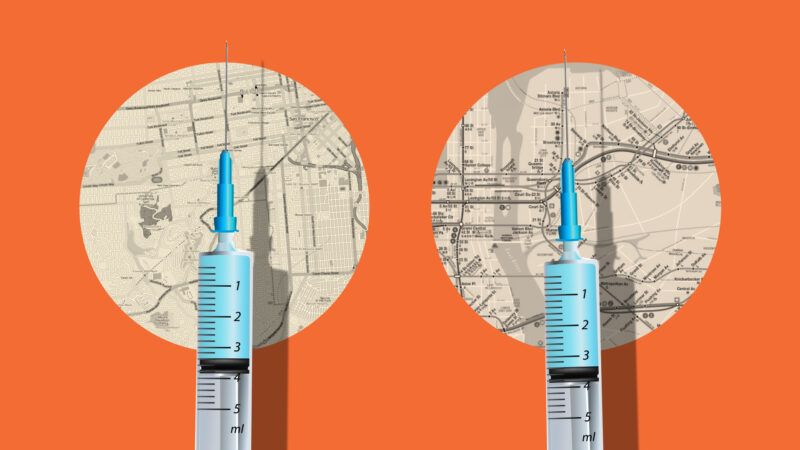NYC and San Francisco Prioritize 'First Doses First' for Monkeypox Vaccine. Why Won't the CDC Do the Same?
The CDC and FDA, when confronted with scarce vaccine supply, refuse to learn from their COVID-19 mistakes.

For many people, COVID-19 fears have long receded, replaced by a sense that public health bodies failed us when they were needed most. The Food and Drug Administration (FDA) and Centers for Disease Control and Prevention (CDC) initially lied about mask efficacy in order to ration them for frontline workers; were slow to approve diagnostic tests, which were frequently riddled with problems; were slow to approve vaccines, even those that had been approved by European health regulators; and, when vaccines were finally approved—after regulators had taken weekends off—let teachers and other workers skip the line ahead of elderly people to receive their vaccine doses, erroneously assuming this would get teachers to return to their shuttered classrooms.
Now, both the CDC and the FDA are repeating the same mistakes. California, Illinois, and New York have declared states of emergency over their rates of spread, while nearly 6,000 cases have been reported nationwide. For gay and bisexual men under age 50 who have never been vaccinated against smallpox (which confers decent protection against monkeypox), accessing the vaccine as quickly as possible will be the best way to minimize this outbreak's harm.
The best way to do that would be a "first doses first" approach. It's one San Francisco, Washington, D.C., and New York City have taken. It's one many people advocated for during the early COVID vaccination campaign of 2021, when vaccine supply was limited and case counts remained high. It's also one the FDA and CDC refuse to endorse.
"While the FDA understands the desire to get out as many doses as possible, the agency advises against departing from the product labeling," a spokesperson told The Washington Post. "You just need a higher level of protection than one dose will give you," said CDC Director Rochelle Walensky, failing to note that some protection is surely better than none.
About 3.2 million doses are needed to cover the most at-risk population. The U.S. currently has 1.1 million Jynneos doses (including the almost 800,000 that were languishing in a warehouse in Denmark for many weeks, unable to get in arms due to the FDA needing to inspect and authorize the Danish plant). This means 550,000 people can get fully vaccinated by year's end, unless conditions improve—amounting to one-sixth of the population that really needs it.
"The bad news is that we are making all the same mistakes we made with Covid," Alex Tabarrok, the George Mason University economist and Marginal Revolution blogger, tells Reason. "The good news is that we are correcting our errors more quickly. The yet to be determined news is whether we are correcting our errors fast enough."
"When I suggested first doses first for Covid it was controversial, I got a lot of pushback and although Britain and Canada switched, the US never did," says Tabarrok. "Now public health organizations around the country are routinely ignoring CDC advice and implementing first doses first for Monkeypox on their own."
Dose rationing and partial dosing are strategies public health agencies ought to implement in times of shortage. One Lancet study has estimated that the administration of COVID-19 vaccines in their first year likely saved some 1.9 million lives in the United States. Vaccinating health care workers and elderly people in residential care facilities was the immediate December 2020 priority in many states, with the Trump administration urging vaccination of all elderly people in mid-January 2021. By late February 2021, most states had gotten the memo, but some nine states had yet to expand eligibility to those 65 and older. How many lives could vaccination have saved in those early days if it had been more swiftly deployed, prioritizing people more simply in order of oldest to youngest, and letting more time between the first and second doses elapse to get as many shots in arms as possible?
"Faced with the challenge of COVID-19, the FDA screwed up on nearly every level," wrote Katherine Mangu-Ward in Reason's May 2021 issue. "When the agency did do something right, it was almost always by making exceptions to its normal policies and procedures."
The CDC and FDA's inability to be nimble and creative with this vaccination campaign provides more fodder for libertarians' long-held thesis that the agencies doing their jobs well is more frequently the exception than the rule. Monkeypox public health messaging has so far been subpar. By fearing stigmatizing men who have sex with men—the group primarily affected by monkeypox, which is mostly sexually transmitted in the current epidemic—public health authorities have failed to emphasize who is most likely to be infected, via which behaviors.
It's good that health authorities held back on shutting down orgies and events—COVID taught us that state-mandated shutdowns frequently fail to alter people's behavior, particularly the least risk-averse types—but many have pointed out that our bureaucrats showed no similar restraint when supporting stay-at-home orders that prevented people from going to church and attending loved ones' funerals. The hypocrisy squanders trust further. Disease control may be best accomplished by simply giving people up-to-date, accurate information, and ensuring they have speedy access to the vaccines that can protect them.
In some ways, health authorities are tackling monkeypox more deftly than they did COVID. But they still refuse to learn from their recent failures, replicating many of the same mistakes.


Show Comments (32)